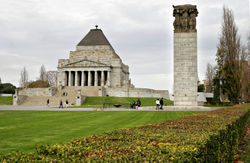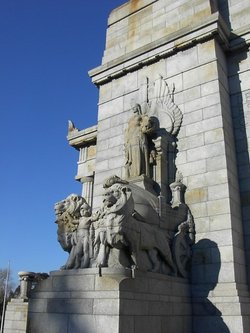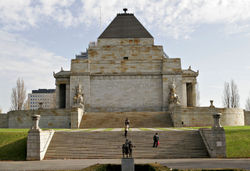Shrine of Remembrance
2007 Schools Wikipedia Selection. Related subjects: Architecture

A view of the northern face of the Shrine showing many visitors paying their respects. The annual ANZAC Day parade approaches the Shrine from the north. This view shows the sculptures in the pediment, clearly inspired by those of the Parthenon. The central figure is the "Call to Arms.".
|
The Shrine of Remembrance, located in St Kilda Road, Melbourne, is one of the largest war memorials in Australia. It was built as a memorial to the men and women of Victoria who served in World War I, but soon came to be seen as Australia's major memorial to all the 60,000 Australians who died in the war. It now serves as a memorial for all Australians who served in war and it is the site of annual observances of ANZAC Day ( 25 April) and Remembrance Day ( 11 November).
History
Proposals for a war memorial in Melbourne were put forward as soon as the war ended in November 1918. In 1920 the Victorian state government appointed an advisory committee, which recommended an "arch of victory" over St Kilda Rd, the major boulevard leading out of the city of Melbourne to the south, and one of the city's busiest thoroughfares. In August 1921 an executive committee was formed, with the former commander of the Australian forces in the war, General Sir John Monash, as its driving force. The committee soon abandoned the idea of an arch and proposed a large monumental memorial to the east of St Kilda Road, a position which would make it clearly visible from the centre of the city. A competition was held for a design, which was won by two Melbourne architects (and war veterans), Phillip Hudson and James Wardrop.
The design of the proposed Shrine was based on the ancient Tomb of Mausolus (the Mausoleum) at Halicarnassus, one of the Seven Wonders of the World. It featured a massive pyramid-shaped structure, with classical porticos at the head of wide flights of steps on the northern and southern sides. The chosen building stone was granodiorite quarried from Tynong. This design was fiercely criticised in the press, especially by Keith Murdoch's Herald, on the grounds of its grandiosity, its severity of design and its expense. Murdoch called the Shrine "a tomb of gloom." Some Christian churches also attacked the design as pagan for having no cross or other Christian element. Monash, who was Jewish, was blamed in some quarters for this, although in fact he had not promoted the Hudson-Wardrop design.
In the face of this criticism, the Victorian government abandoned the project in 1926, and proposed instead to build a cenotaph in a large "ANZAC Square" at the top of Bourke St in front of Parliament House. This, however, would have involved demolishing the Windsor Hotel, one of Melbourne's oldest and grandest. Monash then struck back, turning the 1927 ANZAC Day march, in which he led 30,000 veterans through the streets of Melbourne, into a demonstration in favour of the St Kilda Rd Shrine, gaining the support of the influential Age and Argus newspapers and the powerful Returned and Services League. Faced with this support, the state government changed its mind again.
The foundation stone was laid on 11 November 1927, by the Governor of Victoria, Lord Somers. Although both the Victorian and Commonwealth governments made contributions, most of the cost of the Shrine was raised by public contributions, with Monash as chief fundraiser.
Monash, who had been a civil engineer before 1914, took personal charge of the construction, which began in July 1928. He opposed suggestions that an " unknown soldier" should be buried at the Shrine, on the grounds that this should be done at a national war memorial in the new Australian capital, Canberra. He also rejected suggestions for statues of individual war leaders, including himself. Monash composed the inscription which appears on the western wall of the Shrine:
- LET ALL MEN KNOW THAT THIS IS HOLY GROUND. THIS SHRINE, ESTABLISHED IN THE HEARTS OF MEN AS ON THE SOLID EARTH, COMMEMORATES A PEOPLE'S FORTITUDE AND SACRIFICE. YE THEREFORE THAT COME AFTER, GIVE REMEMBRANCE.
This inscription again aroused criticism for having no Christian element, or religious element at all. In fact it was modelled closely on the memorial inscriptions of Ancient Greece, and reflected Monash's classical education rather than his Judaism. Monash died in 1931 before the Shrine was finished, but its completion was a tribute to his determination. There is a large equestrian statue of Monash in the parklands which surround the Shrine, although there are no memorials to individuals at the Shrine itself.
The inscription on the eastern wall, not written by Monash, reads:
- THIS MONUMENT WAS ERECTED BY A GRATEFUL PEOPLE TO THE HONOURED MEMORY OF THE MEN AND WOMEN WHO SERVED THE EMPIRE IN THE GREAT WAR OF 1914-1918.
The onset of the Great Depression at the end of 1929 slowed construction work on the Shrine. But from 1930 onwards the Depression actually assisted the Shrine's progress, because large numbers of unemployed men were hired at sustenance wages to work on the project as a form of unemployment relief. Many of these were war veterans who welcomed the chance to help finish the Shrine. Work was finally completed in September 1934, and the Shrine was formally dedicated on 11 November 1934 by the Duke of Gloucester, witnessed by a crowd of 300,000, believed to be the largest ever in Melbourne.
After World War II it was felt necessary to add to the Shrine an element commemorating the Australian war dead of the second great conflict. The result was the World War II Forecourt, a wide expanse of stone in front of the Shrine's north face; the Eternal Flame, a permanent gas flame set just to the west of the north face; and the World War II Memorial, a 12.5 m high cenotaph a little further west. The Forecourt replaced a reflecting pool that had been emptied during World War II and was not subsequently refilled. These enlargements were dedicated by Queen Elizabeth II on 28 February 1954. Australia's involvements in later wars, such as the Korean War, the Malayan Emergency, the Vietnam War and the Gulf War, are commemorated by inscriptions.
In 1951 the body of Field Marshal Sir Thomas Blamey, Australia's military commander during World War II, was held at the Shrine for three days for public viewing followed by a State funeral on site. This was the only time that the building has been used other than as war memorial.
During the Vietnam War the Shrine became a centre of conflict when anti-war demonstrators protested during ANZAC Day services against Australia's involvement in the war. In 1971 the Shrine was defaced when the word PEACE was painted in large white letters on the pillars of the north portico. Despite vigorous cleaning, the porous nature of the stone used in the Shrine's construction meant that the slogan remained faintly visible for over 20 years.
In 1985 the Remembrance Garden was added beneath the western face of the Shrine to honour those who served during post-WWII conflicts. The garden features a pool, waterfall and granite wall bearing the names of the conflicts in which Australia participated, such as Kuwait ( Gulf War) and East Timor.
The Shrine today
For the past 70 years the Shrine has been the centre of war commemoration in Melbourne. Although Remembrance Day ( 11 November) is the official day for commemorating the war dead, it has gradually been eclipsed in the public estimation by ANZAC Day ( 25 April), which unlike Remembrance Day is a specifically Australian (and New Zealand) day of commemoration. Every ANZAC Day the Shrine is the site of a dawn service which draws large crowds, and the ANZAC Day march of veterans later in the day concludes in the Shrine's forecourt.
Inside the Shrine is the Sanctuary, which contains the Stone of Remembrance. This is a marble stone sunk below the pavement, where visitors must bow their heads to read the inscription:
- GREATER LOVE HATH NO MAN
The Stone is aligned with an aperture in the roof of the Sanctuary so that a ray of sunlight falls on the word LOVE on the Stone of Remembrance at exactly 11am on 11 November, marking the hour and day of the Armistice which ended World War I. Unfortunately the introduction of daylight saving in Victoria meant that the ray of sunlight was no longer in the right place at 11am. A mirror has now been installed in the roof to direct sunlight onto the Stone at 11am. During the rest of the year, a light is used to simulate the effect.
Around the Sanctuary walls is a frieze of 12 carved panels (by sculptor Pietro Porcelli) depicting the armed services at work and in action during World War I. The Sanctuary is surrounded by a narrow walkway called the Ambulatory. Along the Ambulatory are 42 bronze caskets containing hand-written, illuminated Books of Remembrance with the names of every Victorian who enlisted for active service with the Australian Imperial Force (AIF) or Australian Naval and Military Expeditionary Force in World War I or died in camp prior to embarkation. These books are opened to a different page every day.
Beneath the Sanctuary is the Crypt containing a statue of a father and son, representing the two generations who went to war together. Around the walls are panels listing every unit of the AIF, down to battalion and regiment, along with the colours of their shoulder patch. The Crypt is hung with the standards of various battalions and regiments, listing their battle honours.
The Shrine is set in a large expanse of parkland officially called Kings Domain. Over the years many other war memorials have been built in this area, including the Australian-Hellenic Memorial to Australian and Greek dead in the Battles of Greece and Crete in 1941, and statues of Monash and Blamey. Most of the trees which line the approaches to the Shrine bear plaques commemorating individual Army units, naval vessels or Air Force squadrons, placed there by veterans' groups. An older memorial to Victorians killed in the Second Boer War of 1899- 1902 is also nearby.
At the northeast corner of the Shrine is the Gallipoli Memorial, a small statue of "The Man with the Donkey". Officially the statue represents the "valour and compassion of the Australian soldier" but it is modelled on Private John Simpson Kirkpatrick and the dates on the memorial, April 25 to May 19, represent the period in which Simpson survived at Gallipoli. Nearby is a Turkish Pine grown from a seed of the original Lone Pine at Gallipoli.
By the 1990s the increasing number of visitors to the Shrine led to the construction of a new Visitor Centre and museum inside the Shrine, designed by Melbourne architects Ashton Raggatt McDougall, which was opened in August 2003. The Centre incorporates an auditorium, administration facilities and public conveniences. It offers improved facilities for visitors, including the many school parties which visit the Shrine every day, provides improved access for the elderly and the disabled, and means that the external steps and northern doors need only be used for ceremonial purposes. Access from the Visitor Centre now leads directly into the Crypt up a short flight of stairs. On display in the Visitor Centre is the Victoria Cross won by Captain Robert Grieve during the Battle of Messines, 1917.
As memories of the specific battles of World War I (apart from Gallipoli) have faded in Australia, few people remain aware of the "battle honours" disks, 16 stone discs set in the Shrine's balustrade. These discs are the battle honours granted by King George V and commemorate Australia's contributions to the following battles: Landing at Anzac, (that is, Gallipoli), Sari Bair, Rumani, Gaza-Beersheba, the North Sea, the Cocos Islands, Megiddo, Damascus, Villers Bretonneux, Amiens, Mont St Quentin, the Hindenburg Line, Ypres, Messines, Pozieres and Bullecourt.
The Shrine is managed by a Board of Trustees, appointed by the Victorian Government. The board is responsible for the care, management, maintenance and preservation of the building and development of the Shrine. The Shrine's security has been considerably improved in recent years. A group of Victoria Police guards keep watch over the Shrine at all times. During the hours the Shrine is open to the public or in use for any ceremony, they wear a uniform representing an Australian Light Horseman of World War I with Victoria Police Force insignia.




